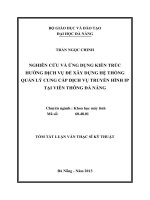Nghiên cứu Vỏ bao che kiến trúc
Bạn đang xem bản rút gọn của tài liệu. Xem và tải ngay bản đầy đủ của tài liệu tại đây (3.74 MB, 30 trang )
Vỏ bao che
Từơng :Kính đục
Gỗ Từơng xanh –
Green wallThe seemingly impossible vertical gardens vegetation growing on soil-less vertical surfaces that are finding
popularity in the ever-more-green-minded media and public are the almost single-handed product of one person:
Patrick Blanc. Kính màu
Hệ thống vỏ bao che dung năng lượng mặt trời
GreenPix - Zero Energy Media Wall, Beijing
GreenPix - Zero Energy Media Wall - is a groundbreaking project applying sustainable and digital mediatechnology
to the curtain wall of Xicui entertainment complex in Beijing, near the site of the 2008 Olympics.Featuring the largest
color LED display worldwide and the first photovoltaic system integrated into a glass curtain wall in China, the
building performs as a self-sufficient organic system, harvesting solar energy by day and using it to illuminate the
screen after dark, mirroring a day’s climatic cycle.
Greenpix behaves like an organic system, absorbing solar energy during the day and then generating light from the
same power that evening.With the support of leading German manufacturers Schueco and SunWays, the architect
Simone Giostra with Arup developed a new technology for laminating photovoltaic cells in a glass curtain wall and
oversaw the production of the first glass solar panels by Chinese manufacturer SunTech. The polycrystalline
photovoltaic cells are laminated within the glass of the curtain wall and placed with changing density on the entire
building’s skin.The density pattern increases building’s performance, allowing natural light when required by interior
program, while reducing heat gain and transforming excessive solar radiation into energy for the media wall.
GreenPix is a large-scale display comprising of 2,292 color (RGB) LED’s light points comparable to a 24,000 sq. ft.
(2.200 m2) monitor screen for dynamic content display. The very large scale and the characteristic low resolution of
the screen enhances the abstract visual qualities of the medium, providing an art-specific communication form in
contrast to commercial applications of high resolution screens in conventional media façades.
via: greenpix.org
The media wall has been embedded with intelligent software, allowing the skin of the building to respond to internal
and external data, creating a unique, ‘responsive environment for entertainment and public engagement’. The design
is specifically large scale and low resolution so as to provide an ‘art-specific’ media facade. Future content for the
media wall is expected to include Olympic events, site-specific video-art installations, weather forecasts and video
gaming. The entertainment center will house the first venue dedicated to media art in Beijing.
Vỏ bao che động
FLARE is a modular system to create a dynamic hull for facades or any building or wall surface. Acting like a living
skin, it allows a building to express, communicate and interact with its environment.
FLARE turns the building facade into a penetrable kinetic membrane, breaking with all conventions of the building
surface as a static skin.
FLARE units
The FLARE system consists of a number of tiltable metal flake bodies supplemented by individually controllable
pneumatic cylinders.
Due to the developed pattern, an infinite array of flakes can be mounted on any building or wall surface in a modular
system of multiplied FLARE units.
The visual effect
Each metal flake reflects the bright sky or sunlight when in vertical standby position.
When the flake is tilted downwards by a computer controlled pneumatic piston, its face is shaded from the sky light
and this way appears as a dark pixel.
By reflecting ambient or direct sunlight, the individual flakes of the FLARE system act like pixels formed by natural
light.
The system is controlled by a computer to form any kind of surface animation. Sensor systems inside and outside the
building communicate the buildings activity directly to the FLARE system which acts as the buildings lateral line.
Lam gấp
The idea of a "folding facade" is not entirely new. Shuttered exteriors have traditionally been used in various locales
for protection from the elements, from New Orleans to New England in the United States, and in most other parts of
the globe. What separates the newfound use of a folding perimeter to the traditional use is extent and purpose.
[Carabanchel Housing | photo by Francisco Andeyro Garcia and Alejandro Garcia Gonzalez]









